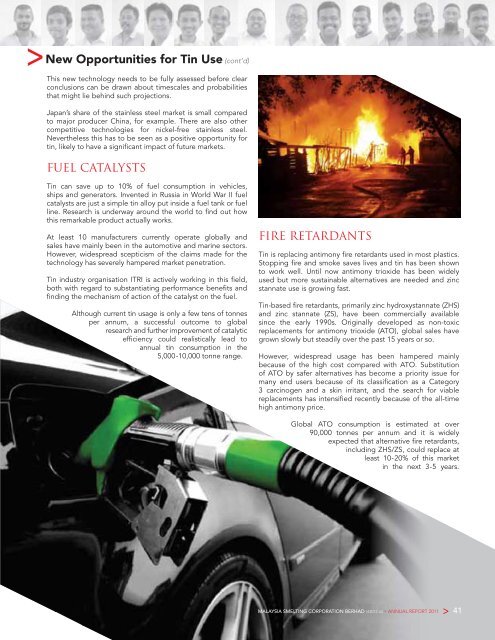Download PDF - ChartNexus
Download PDF - ChartNexus
Download PDF - ChartNexus
Create successful ePaper yourself
Turn your PDF publications into a flip-book with our unique Google optimized e-Paper software.
New Opportunities for Tin Use (cont’d)<br />
This new technology needs to be fully assessed before clear<br />
conclusions can be drawn about timescales and probabilities<br />
that might lie behind such projections.<br />
Japan’s share of the stainless steel market is small compared<br />
to major producer China, for example. There are also other<br />
competitive technologies for nickel-free stainless steel.<br />
Nevertheless this has to be seen as a positive opportunity for<br />
tin, likely to have a significant impact of future markets.<br />
FUel catalYStS<br />
Tin can save up to 10% of fuel consumption in vehicles,<br />
ships and generators. Invented in Russia in World War II fuel<br />
catalysts are just a simple tin alloy put inside a fuel tank or fuel<br />
line. Research is underway around the world to find out how<br />
this remarkable product actually works.<br />
At least 10 manufacturers currently operate globally and<br />
sales have mainly been in the automotive and marine sectors.<br />
However, widespread scepticism of the claims made for the<br />
technology has severely hampered market penetration.<br />
Tin industry organisation ITRI is actively working in this field,<br />
both with regard to substantiating performance benefits and<br />
finding the mechanism of action of the catalyst on the fuel.<br />
Although current tin usage is only a few tens of tonnes<br />
per annum, a successful outcome to global<br />
research and further improvement of catalytic<br />
efficiency could realistically lead to<br />
annual tin consumption in the<br />
5,000-10,000 tonne range.<br />
FIRe RetaRDantS<br />
Tin is replacing antimony fire retardants used in most plastics.<br />
Stopping fire and smoke saves lives and tin has been shown<br />
to work well. Until now antimony trioxide has been widely<br />
used but more sustainable alternatives are needed and zinc<br />
stannate use is growing fast.<br />
Tin-based fire retardants, primarily zinc hydroxystannate (ZHS)<br />
and zinc stannate (ZS), have been commercially available<br />
since the early 1990s. Originally developed as non-toxic<br />
replacements for antimony trioxide (ATO), global sales have<br />
grown slowly but steadily over the past 15 years or so.<br />
However, widespread usage has been hampered mainly<br />
because of the high cost compared with ATO. Substitution<br />
of ATO by safer alternatives has become a priority issue for<br />
many end users because of its classification as a Category<br />
3 carcinogen and a skin irritant, and the search for viable<br />
replacements has intensified recently because of the all-time<br />
high antimony price.<br />
Global ATO consumption is estimated at over<br />
90,000 tonnes per annum and it is widely<br />
expected that alternative fire retardants,<br />
including ZHS/ZS, could replace at<br />
least 10-20% of this market<br />
in the next 3-5 years.<br />
MALAYSIA SMELTING CORPORATION BERHAD (43072-A) • ANNUAL REPORT 2011 41
















